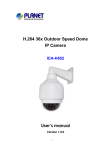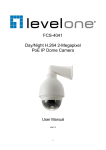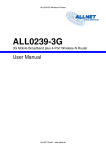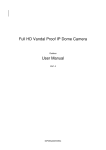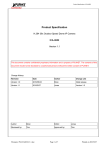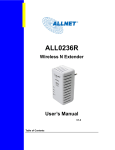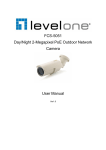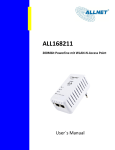Download ALL2298 High Speed Dome Camera User`s Manual
Transcript
ALL2298 High Speed Dome Camera User’s Manual V1.0 Table of Contents High Speed Dome Camera Version 1.0 Table of Contents 1. OVERVIEW ........................................................................................................................................ 4 1.1 1.2 2. PACKAGE CONTENTS......................................................................................................................... 5 SWITCH/CONNECTOR DEFINITION ................................................................................................ 8 PREPARATIONS FOR DOME CAMERA SETUP ........................................................................ 9 2.1 2.2 SYSTEM REQUIREMENTS .............................................................................................................. 9 CABLE CONNECTION .................................................................................................................. 10 3. ACCESSING IP CAMERA .............................................................................................................. 12 4. CONFIGURATION & OPERATION ............................................................................................. 19 4.1 4.2 4.3 4.3.1 4.3.2 4.3.3 4.3.4 4.3.5 4.3.6 4.3.7 4.3.8 4.3.9 4.3.10 4.3.11 4.3.12 4.3.13 4.3.14 4.4 4.4.1 4.4.2 4.4.3 4.4.4 4.4.5 4.5 4.5.1 4.5.2 4.5.3 4.5.4 4.5.5 4.5.6 4.5.7 4.5.8 4.5.9 4.5.10 4.5.11 4.5.12 4.6 5. BROWSER-BASED VIEWER INTRODUCTION ..................................................................................... 19 4.2 HOME PAGE ............................................................................................................................... 21 SYSTEM RELATED SETTINGS ........................................................................................................... 25 Host Name and System Time Setting ..................................................................................... 26 Security ................................................................................................................................. 27 Network................................................................................................................................. 30 DDNS .................................................................................................................................... 35 Mail ...................................................................................................................................... 36 FTP ....................................................................................................................................... 37 Application (Alarm Settings) ................................................................................................ 37 Snapshot ............................................................................................................................... 43 View Log File ........................................................................................................................ 44 View User Information ..................................................................................................... 45 View Parameters ................................................................................................................... 47 Factory Default ................................................................................................................ 48 Software Version .............................................................................................................. 49 Software Upgrade ............................................................................................................ 50 VIDEO AND AUDIO STREAMING SETTINGS ...................................................................................... 54 Video Resolution and Video Deinterlacing Function ............................................................ 54 Video Compression ............................................................................................................... 55 Video OCX Protocol ............................................................................................................. 57 Video Frame Skip.................................................................................................................. 58 Audio Mode and Bit Rate Settings ........................................................................................ 59 PTZ SETTINGS ................................................................................................................................ 61 Preset Programming ............................................................................................................. 62 Cruise Programming ............................................................................................................ 63 Auto Pan Programming ........................................................................................................ 64 Sequence Line Programming ................................................................................................ 65 Home Function ..................................................................................................................... 67 Tilt Angle Settings ................................................................................................................. 69 Privacy Mask Settings .......................................................................................................... 70 Camera— Exposure .............................................................................................................. 72 Camera—WB Mode .............................................................................................................. 73 Camera—Miscellaneous Setups Menu 1.......................................................................... 74 Camera—Miscellaneous Setups Menu 2 .............................................................................. 77 Default Settings ................................................................................................................ 78 LOGOUT .......................................................................................................................................... 79 CMS SOFTWARE INTRODUCTION ........................................................................................... 80 APPENDIX A: TECHNICAL SPECIFICATIONS ................................................................................. 81 APPENDIX B: INTERNET SECURITY SETTINGS............................................................................. 83 2 High Speed Dome Camera Version 1.0 APPENDIX C: DC VIEWER DOWNLOAD PROCEDURE................................................................. 86 APPENDIX D: UPGRADE THE DC VIEWER ...................................................................................... 89 APPENDIX E: INSTALL UPNP COMPONENTS .................................................................................. 93 COPYRIGHT ............................................................................................................................................. 97 3 High Speed Dome Camera 1. Version 1.0 Overview The network Speed Dome Camera transmits digital video and audio data using wire connection. Live video can be monitored and recorded from window-based computer via network. The video encoder supports real-time Main Profile H.264 D1 resolution which compresses the image size up to 40% off. Simultaneous dual streams, H.264/H.264 and H.264/MJPEG, are available for various network applications via speeding or limited bandwidth. Better image quality and high resolution are delivered by IP support. Additionally, 3D de-interlaced technology provides superior image quality. It eliminates the “combing” effect due to scene change and performs more stabilized image. With IP solution, multiple and authorized users can view the immediate image from any location through network even using a standard web-browser. It enables users to access and remote the camera without at specific locations. Features 12x Optical Zoom 12x Digital Zoom Simultaneous dual streams: H.264 and MJPEG D1 Real-time Resolution 3D de-interlaced video image Two-way audio support Removable IR Cut Filter Motion Detection Wide Dynamic Range (WDR) 2D/ 3D Noise Reduction 4 High Speed Dome Camera 1.1 Version 1.0 Package Contents Please check the box contains the items listed here. If any item is missing or has defects, DO NOT install or operate the product and contact your dealer for assistance. Indoor Dome Camera-Classic Model Dome Camera Power Adaptor & Power Cord (DC model only) Data Cable for Power Supply, Video and Audio (DC 12V) Data Cable for Power Supply, Video and Audio (AC 24V) Quick Guide Hard Ceiling Mount & Decoration Ring M3 Screw, Fixing Plate CD: Operation Manuals 5 High Speed Dome Camera Version 1.0 Indoor Dome Camera-Standard Model Dome Camera Power Adaptor & Power Cord (DC model only) Data Cable for Power Supply, Video and Audio (DC 12V) Data Cable for Power Supply, Video and Audio (AC 24V) Quick Guide M3 Screw, Fixing Plate Hard Ceiling Mount CD: Operation Manuals 6 High Speed Dome Camera Version 1.0 Outdoor Dome Camera Package Data Cable for Power Supply, Video, Audio and Alarm (AC 24V) Dome Camera with Outdoor Mount Kit Waterproof Rubber M3 Standard Screw (x1) M3 Security Screw (x1) * M5 Standard Screw (x1) M5 Security Screw (x1) * Lubricant Security Torx* Quick Guide CD: Operation Manuals Optical Cover *Optional: For Vandal Proof Cover only. 7 High Speed Dome Camera 1.2 Version 1.0 Switch/Connector Definition There are various switches and connectors located on the Dome Camera’s back plate as shown in the figures below. Please refer to the diagrams and tables accompanied with for use of each switch/connector. Indoor-Classic Model A B C D E F G Indoor-Standard Model Outdoor Model None Communication Switch (Reserved) RJ45 Connector 22-Pin Connector None F-1 Reboot Button F-2 Factory Reset Button ISP Connector (for FW upgrade) NOTE: DO NOT change the network Speed Dome Camera’s Communication Switch factory default settings. 8 High Speed Dome Camera 2. Version 1.0 Preparations for Dome Camera Setup Before logging in, please complete power, alarm (if available) and network connections and check system requirements. For further details and instructions on cable connection, please refer to the following sections. 2.1 System Requirements To perform the network Speed Dome Camera via web browser, please ensure your PC is in good network connection, and meet system requirement as described below. Items Personal Computer Operating System Web Browser Network Card Viewer Minimum Requirement 1. Intel Pentium IV, 3 GHz or higher, Intel Core2 Duo, 2 GHz or higher 2. 1 GB RAM or more 3. AGP graphics card 64 MB RAM, DirectDraw Windows VISTA or Windows XP Microsoft Internet Explorer 6.0 or later 10Base-T (10 Mbps) or 100Base-TX (100 Mbps) operation ActiveX control plug-in for Microsoft IE 9 High Speed Dome Camera 2.2 Version 1.0 Cable Connection Data Cable Connection For the indoor Dome Camera, it is supplied with a DC 12V or an AC 24V Data Cable for a quick installation for demo or testing usage, while the outdoor model is only supplied with an AC 24V Data Cable. All of the Data Cables for different types of camera are shown as follows: Indoor Dome Camera AC 24V Data Cable DC 12V Data Cable Outdoor Dome Camera AC 24V Data Cable 10 High Speed Dome Camera Version 1.0 The network Speed Dome Camera’s 22-pin connector definition is listed as shown below. Pin 1 2 3 4 5 6 7 8 9 10 11 Definition Cable AC 24-1/DC 20AWG/18AWG (+) ALM NC AC 24-2/DC 20AWG/18AWG (-) ALM NO FG 20AWG18AWG ALM COM Audio in Audio out 24AWG Audio GND Audio GND ISOG Pin 12 Definition ALM-1 13 14 ALM-3 ALM-2 15 16 17 18 19 20 21 22 ALM-4 Reserved Reserved Reserved Reserved ALM GND VGND Video Cable 20AWG Ethernet Cable Connection Use of Category 5 Ethernet cable is recommended for network connection; to have best transmission quality, cable length shall not exceed 100 meters. Connect one end of the Ethernet cable to the RJ45 connector on the Dome Camera’s back plate, and the other end of the cable to the network switch or PC. NOTE: In some cases, you may need use an Ethernet crossover cable when connecting the IP Camera directly to the PC. Check the status of the link indicator and activity indicator LEDs; if the LEDs are unlit, please check LAN connection. Green Link Light indicates good network connection. Orange Activity Light flashes for network activity indication. 11 High Speed Dome Camera 3. Version 1.0 Accessing IP Camera For initial access to the network Speed Dome Camera, users can search the camera through the installer program: DeviceSearch.exe, which can be found in “DeviceSearch” folder in the supplied CD. Device Search Software Setup Step 1: Double click on the program Device Search.exe (see the icon below); its window will appear as shown below. Then click the “Device Search” button. Step 2: The security alert window will pop up. Click “Unblock” to continue. 12 High Speed Dome Camera Version 1.0 Device Search Step 3: Click “Device Search” again, and all the finding IP devices will be listed in the page, as shown in the figure below. The network Speed Dome Camera’s default IP address is: DHCP. Step 4: camera Double click or right click and select “Browse” to access the directly via web browser. Step 5: Then the prompt window of request for entering default username and password (as shown below) will appear for login to the network Speed Dome Camera. 13 High Speed Dome Camera Version 1.0 The default login ID and password for the Administrator are: Login ID Admin Password 1234 NOTE: ID and password are case sensitive. NOTE: It is strongly advised that administrator’s password be altered for the security concerns. Refer to section 4.3.2 Security for further details. Additionally, users can change the network Speed Dome Camera’s network property, either DHCP or Static IP directly in the device finding list. Refer to the following section for changing the network Speed Dome Camera’s network property. 14 High Speed Dome Camera Version 1.0 Example of Changing IP Camera’s Network Property Users can directly change an Network Speed Dome Camera’s network property, ex. from static IP to DHCP, in the finding device list. The way to change the camera’s network property is specified below: Step 1: In the finding device list, click on the network Speed Dome Camera that you would like to change its network property. On the selected item, right click and select “Network Setup.” Meanwhile, record the network Speed Dome Camera’s MAC address, for future identification. Step 2: The “Network Setup” page will come out. Select “DHCP,” and press “Apply” button down the page. 15 High Speed Dome Camera Version 1.0 Step 3: Click “OK” on the Note of setting change. Wait for one minute to research the network Speed Dome Camera. Step 4: Click the “Device Search” button to re-search all the devices. Then select the network Speed Dome Camera with the correct MAC address. Double click on the IP Camera, and the login window will come out. Step 5: Enter User name and Password to access the network Speed Dome Camera. Installing DC Viewer Software Online For the initial access to the network Speed Dome Camera, a client program, DC Viewer, will be automatically installed to your PC when connecting to the IP Camera. If the Web browser doesn’t allow DC Viewer installation, please check the Internet security settings or ActiveX controls and plug-ins settings (see Appendix B: Internet Security Settings) to continue the process. The Information Bar (just below the URL bar) may come out and ask for permission to install the ActiveX Control for displaying video in browser (see the figure below). Right click on the Information Bar and select “Install ActiveX Control…” to allow the installation. 16 High Speed Dome Camera Version 1.0 Then the security warning window will pop up. Click “Install” to carry on software installation. Click “Finish” to close the DC Viewer window when download is finished. For the detailed software download procedure, please refer to Appendix C: DC Viewer Download Procedure. NOTE: If the Live Video Pane on Home Page can not be shown for users who have installed the DC Viewer in the PC previously. Please refer to Appendix D: Upgrade the DC Viewer. Once login to the network Speed Dome Camera, users will see the Home page as shown below: NOTE: Please note that the function buttons will vary depending on the camera model. Administrator/User Privileges “Administrator” represents the person who can configure the network Speed Dome Camera and authorize users access to the camera; “User” refers to whoever has access to the camera with limited authority, i.e. entering Home and 17 High Speed Dome Camera Version 1.0 Camera setting pages. Image and Focus Adjustment The image displays on the Home page when successfully accessing to the IP Dome Camera. Adjust zoom and focus as necessary to produce a clear image. 18 High Speed Dome Camera 4. Version 1.0 Configuration & Operation The network Speed Dome Camera is provided with a user-friendly browser-based configuration interface, and a free bundled CMS (Central Management System) for video playback and recording. In this chapter, information about main page introduction, system related settings and camera settings will be described in detail. For further information about CMS software, please refer to 5. CMS Software Introduction and CMS user manual. 4.1 Browser-based Viewer Introduction The figure below shows the main page of the network Speed Dome Camera user interface. 19 High Speed Dome Camera Version 1.0 NOTE: Please note that the function buttons will vary depending on the camera model. There are five tabs: Home, System, Streaming, PTZ and Logout on the top panel. Home Users can monitor live video of the targeted area. System setting The Administrator can set host name, system time, root password, network related settings, etc. Further details will be interpreted in section 4.3 System Related Settings. Streaming setting The Administrator can modify video resolution and rotate type and select video compression mode in this page. PTZ setting Users can adjust various camera parameters including <Exposure>, <White Balance>, <Brightness>, <Sharpness>, <Contrast> and <Digital Zoom>. Logout Click on the tab to re-login the network Speed Dome Camera with another username and password. 20 High Speed Dome Camera 4.2 Version 1.0 Home Page In the Home page, there are several function buttons below the displayed image. NOTE: Please note that the function buttons will vary depending on the camera model. Screen Size Adjustment Image display size can be adjusted to x1/2 and full screen. Digital Zoom Control In the full screen mode, users can implement digital PTZ by rotating the mouse wheel (for zoom in/out), and drag the mouse into any direction. button (on/off) Talk Talk function allows the local site talks to the remote site. Click on the button to switch it to on/off. Please refer to section 4.3.2 Security: Add user >> Talk/Listen for further details. 21 High Speed Dome Camera Version 1.0 This function is only open to “User” who has been granted this privilege by the Administrator. button Snapshot Press the button, and the JPEG snapshots will automatically be saved in the appointed place. The default place of saving snapshots is: C:\. To change the storage location, please refer to section 4.3.11 File Location for further details. Pan/Tilt Control Users can implement pan/tilt control by first moving the cursor to the live video pane; then left click and drag the pointer in any direction. Optical/Digital Zoom Control In Normal View display mode, users can implement zoom in/out by first moving the cursor to the live video pane and then rotating the mouse wheel. As in Full Screen mode, users can directly rotate the mouse wheel to zoom in/out on the image. Digital zoom is only available when the function is activated and which is set in “Camera-Misc1” page under the “PTZ” tab; see section 4.5.10 Camera—Miscellaneous Setups Menu 1 for details. When the camera reaches the limit of its optical range, it will automatically switch to digital zoom. Zoom Adjustment Click on the buttons wide/ tele to control zoom in/out. Move the cursor closely onto the zoom adjustment bar and click on the desired position to change the room ratio. Focus Adjustment Auto Focus (Continuous AF): Click on the “auto” button to enable AF mode. In this mode, the camera will keep in focus automatically and continuously regardless of zoom changes or any view changes. The Focus status will also be displayed above the live video pane as shown below. 22 High Speed Dome Camera Version 1.0 Manual Focus: Click on the “manual” button, and users can adjust focus manually via “near” and “far” buttons. The status will also be displayed above the screen as shown below. 23 High Speed Dome Camera Version 1.0 24 High Speed Dome Camera 4.3 Version 1.0 System Related Settings The figure below shows all categories under the “System” tab. Each category in the left column will be explained in the following sections. NOTE: The “System” configuration page is only accessible by Administrator. 25 High Speed Dome Camera 4.3.1 Version 1.0 Host Name and System Time Setting Press the first category: <System> in the left column; the page is shown as below. Host Name The name is for camera identification. If alarm function (see 4.3.7 Application) is enabled and is set to send alarm message by Mail/FTP, the host name entered here will display in the alarm message. Time Zone Select the time zone you are in from the drop-down menu. Sync With Computer Time Select the item, and video date and time display will synchronize with the PC’s. Manual The Administrator can set video date, time and day manually. Entry format should be identical with that shown next to the enter field. 26 High Speed Dome Camera Version 1.0 Sync with NTP Server Network Time Protocol (NTP) is an alternate way to synchronize your camera’s clock with a NTP server. Please specify the server you wish to synchronize in the enter field. Then select an update interval from the drop-down menu. For further information about NTP, please see the web site: www.ntp.org. 4.3.2 Security Click the category: <Security>, and the page is shown as the figure below. Root password Change the administrator’s password by inputting the new password in both text boxes. The input characters/numbers will be displayed as dots for security purposes. After clicking <Save>, the web browser will ask the Administrator for the new password for access. The maximum length of the password is 14 digits. 27 High Speed Dome Camera Version 1.0 NOTE: The following characters are valid: A-Z, a-z, 09, !#$%&’-.@^_~. Add user Type the new user's name and password and click <Add> to add the new user. Both user name and password can be up to 16 characters. The new user will be displayed in the user name list. There is a maximum of twenty user accounts. Each user can be assigned the privileges of “Camera control”, “Talk” and “Listen”. I/O access This item supports fundamental functions that enable users to view video when accessing to the camera. Camera control This item allows the appointed User to change camera parameters on the Camera Setting page. Talk/Listen Talk and Listen functions allow the appointed user in the local site (PC site) communicating with, for instance, the administrator in the remote site. Manage User Delete user To delete a user, pull down the user list, and select the user name you wish to delete. Then click <Delete> to remove it. Edit user Pull down the user list and select a user name. Click <Edit> to edit the user’s password and privilege. NOTE: It is required to enter the User password as well as select the function open to the user. When finished, click <Save> to modify the account authority. 28 High Speed Dome Camera Version 1.0 29 High Speed Dome Camera 4.3.3 Version 1.0 Network Click <Network> in the left column, and the page will display as shown below. Users can choose to use fixed IP address or dynamic (DHCP) IP address. The following is descriptions for the two ways of setting IP address. Get IP address automatically (DHCP) The camera’s default setting is “Use fixed IP address”. Please refer to the previous section 3. Accessing IP Camera for login with the default IP address. If select “Get IP address automatically”, after the network Speed Dome Camera restarts, users can search it through the installer program: DeviceSearch.exe, which can be found in “DeviceSearch” folder in the supplied CD. NOTE: Please make the record of the network Speed Dome Camera’s MAC address, which can be found in the label of the camera, for identification in the future. 30 High Speed Dome Camera Version 1.0 Use fixed IP address To setup static IP address, select “Use fixed IP address” and move the cursor to the IP address blank (as indicated below) and insert the new IP address, ex. 192.168.7.123; then go to the Default gateway (explained latter) blank and change the setting, ex. 192.168.7.254. Press “Save” to confirm the new setting. 31 High Speed Dome Camera Version 1.0 When using static IP address to login to the network Speed Dome Camera, users can access it either through “DeviceSearch” software (see 3. Accessing IP Camera) or input the IP address in the URL bar and press “Enter”. IP address This is necessary for network identification. Subnet mask It is used to determine if the destination is in the same subnet. The default value is “255.255.255.0”. Default gateway This is the gateway used to forward frames to destinations in different subnet. Invalid gateway setting will fail the transmission to destinations in different subnet. Primary DNS Primary DNS is the primary domain name server that translates hostnames into IP addresses. Secondary DNS Secondary DNS is a secondary domain name server that backups the primary DNS. Advanced Web Server Port The default web server port is 80. Once the port is changed, the user must be notified the change for the connection to be successful. For instance, when the Administrator changes the HTTP port of the IP Camera whose IP address is 192.168.0.100 from 80 to 8080, the user must type in the web browser “http://192.168.0.100:8080” instead of “http://192.168.0.100”. RTSP port RTSP port could be set from 1 to 65535. (Normal Setting Port: 554, 1024 ~65535) 32 High Speed Dome Camera Version 1.0 MJPEG over HTTP port The default setting of HTTP Port is 8008; setting range: 1024 ~65535. NOTE: Be aware to choose the different port from the one set for the web server port. UPnP Setting Enable UPnP When the UPnP is enable, whenever the network Speed Dome Camera is presented to the LAN, the icon of the connected network Speed Dome Cameras will appear in My Network Places to allow for direct access as shown below. 33 High Speed Dome Camera Version 1.0 NOTE: To enable this function, please make sure the UPnP component is installed on your computer. Please refer to Appendix E: Install UPnP components for UPnP component installation procedure. Enable UPnP port forwarding When the UPnP port forwarding is enabled, the network Speed Dome Camera is allowed to open the web server port on the router automatically. NOTE: To enable this function, please make sure that your router supports UPnP and it is activated Friendly name Set the name for the IP Dome Camera for identity. 34 High Speed Dome Camera 4.3.4 Version 1.0 DDNS Dynamic Domain Name System (DDNS) allows a host name to be constantly synchronized with a dynamic IP address. In other words, it allows those using a dynamic IP address to be associated to a static domain name so others can connect to it by name. Enable DDNS Check the item to enable DDNS. Provider Select one DDNS host from the provider list. Host name Enter the registered domain name in the field. Username/E-mail Enter the username or e-mail required by the DDNS provider for authentication. Password/Key 35 High Speed Dome Camera Version 1.0 Enter the password or key required by the DDNS provider for authentication. 4.3.5 Mail The Administrator can send an e-mail via Simple Mail Transfer Protocol (SMTP) when an alarm is triggered. SMTP is a protocol for sending e-mail messages between servers. SMTP is a relatively simple, text-based protocol, where one or more recipients of a message are specified and the message text is transferred. The configuration page is shown as follows: Two sets of SMTP can be configured. Each set includes SMTP Server, Account Name, Password and E-mail Address settings. For SMTP server, contact your network service provider for more specific information. 36 High Speed Dome Camera 4.3.6 Version 1.0 FTP The Administrator can set as sending alarm message to a specific File Transfer Protocol (FTP) site when an alarm is triggered. Users can assign alarm message to up to two FTP sites. The FTP setting page is shown below. Enter the FTP details, which include server, server port, user name, password and remote folder, in the fields. Press “Save” when finished. 4.3.7 Application (Alarm Settings) The network Speed Dome Camera supports 5 alarm inputs and 1 37 High Speed Dome Camera Version 1.0 alarm output. Please make sure the alarm connections are properly wired before starting to configure alarm related settings on this “Application” page. Please refer to the pin definition table below for alarm system wiring. Pin 1 2 3 4 5 6 7 8 9 10 11 Definition AC 24-1/DC (+) ALM NC AC 24-2/DC (-) ALM NO FG ALM COM Audio in Audio out Audio GND Audio GND ISOG Cable 20AWG/18AWG 20AWG/18AWG 20AWG18AWG 24AWG Pin Definition 12 ALM-1 13 14 ALM-3 ALM-2 15 16 17 18 19 20 21 22 ALM-4 Reserved Reserved Reserved Reserved ALM GND VGND Video Cable 20AWG 38 High Speed Dome Camera Version 1.0 Alarm Pin Selection Select an alarm pin which is to be configured from the “Alarm Pin Selection” field. Then press the button “Edit” below the field to carry on alarm programming. Alarm Status Settings The specific alarm pin’s property can be programmed in this section as shown below. Alarm Switch Alarm Switch The Administrator can enable or disable the alarm function. Alarm Type Select an alarm type, “Normal close” or “Normal open,” that corresponds with the alarm application. Triggered Action (Multi-option) The Administrator can specify alarm actions that will take when the 39 High Speed Dome Camera Version 1.0 alarm is triggered. All options are listed as follows: Enable Alarm Output Select the item to enable alarm relay output. Send Alarm Message by FTP/E-Mail The Administrator can select whether to send an alarm message by FTP and/or E-Mail when an alarm is triggered. Upload Image by FTP Select this item, and the Administrator can assign a FTP site and configure various parameters as shown in the figure below. When the alarm is triggered, event images will be uploaded to the appointed FTP site. Upload Image by E-Mail Select this item, and the Administrator can assign an e-mail address and configure various parameters as shown in the figure below. When the alarm is triggered, event images will be sent to the appointed e-mail address. 40 High Speed Dome Camera Version 1.0 NOTE: Make sure SMTP or FTP configuration has been completed. Please refer to section 4.3.5 Mail and 4.3.6 FTP for further details. Function Assign a camera function: Preset, Sequence, Autopan or Cruise, and specify a Preset Point/Sequence Line/ Autopan Path/Cruise Line for the camera to perform at an alarm occurrence. NOTE: Please refer to the sections through 4.5.1 Preset Programming to 4.5.4 Sequence Line Programming for details of Preset Point / Sequence Line / Autopan Path / Cruise Line setups. If the selected function is “Preset,” it is required to enter its dwell time (1 ~ 256 sec.) in the corresponding field as shown below. When the alarm is triggered, the camera will go to the selected Preset Point and stay there for a user-defined period of time. As for other function modes, the camera will keep executing the specified function; to stop the performance, simply change the camera’s status. 41 High Speed Dome Camera Version 1.0 NOTE: The dwell time is only adjustable when selecting Preset as the alarm action. When the dwell time is up, the network Speed Dome Camera will go back to its trigger position and recheck alarm pin status. File Name Enter a file name in the File name field, ex. image.jpg. The uploaded image’s file name format can be set in this section. Please select the one that meets your requirements. Add date/time suffix File name: imageYYMMDD_HHNNSS_XX.jpg Y: Year, M: Month, D: Day H: Hour, N: Minute, S: Second X: Sequence Number Add sequence number suffix (no maximum value) File name: imageXXXXXXX.jpg X: Sequence Number Add sequence number suffix (limited value) File Name: imageXX.jpg 42 High Speed Dome Camera Version 1.0 X: Sequence Number The file name suffix will end at the number being set. For example, if the setting is up to “10,” the file name will start from 00, end at 10, and then start all over again. Overwrite The original image in the FTP site will be overwritten by the new uploaded file with a static filename. Save After complete all the settings mentions above, please click on the Save button to save all the settings in this page. 4.3.8 Snapshot The network Speed Dome Camera supports JPEG snapshot function. Users can specify a storage location for the snapshots. The default setting is: C:\. Once confirm the setting, press “Save,” and all the snapshots will be saved in the designate location. NOTE: Make sure the selected file path contains valid 43 High Speed Dome Camera Version 1.0 characters such as letters and numbers. 4.3.9 View Log File Click on the link to view the system log file. The content of the file provides useful information about configuration and connections after system boot-up. 44 High Speed Dome Camera 4.3.10 Version 1.0 View User Information The Administrator can view each added user’s login information and privileges (see 4.3.2 Security). View User Login Information All the users in the network will be listed in the “User information” zone, as shown below. As the figure below shows: User: 4321 45 High Speed Dome Camera Version 1.0 It indicates that one user’s login username is: User, and password is: 4321. View User Privilege Press “get user privacy” down the page, and the Administrator can view each user’s privileges. 46 High Speed Dome Camera Version 1.0 As the figure above shows: User: 1:1:0:1 1:1:0:1= I/O access : Camera control : Talk : Listen (see 4.3.2 Security) Therefore, it denotes the user is granted privileges of I/O access, Camera control and Listen. 4.3.11 View Parameters Click on this item to view the entire system’s parameter setting. 47 High Speed Dome Camera 4.3.12 Version 1.0 Factory Default The factory default setting page is shown as below. Follow the instructions to reset the network Speed Dome Camera to factory default settings if needed. 48 High Speed Dome Camera Version 1.0 Set Default Click on the “Set Default” button to recall the factory default settings. Then the system will restart in 30 seconds. NOTE: The IP address will be restored to default. Reboot Click on the “Reboot” button, and the system will restart without changing current settings. 4.3.13 Software Version The current software version is displayed in the software version page, which is shown as the figure below. 49 High Speed Dome Camera 4.3.14 Version 1.0 Software Upgrade Software upgrade can be carried out in the “Software Upgrade” page, as shown below. 50 High Speed Dome Camera Version 1.0 NOTE: Make sure the upgrade software file is available before carrying out software upgrade. The procedure of software upgrade is like the following: Step 1: Click “Browse” and select the binary file to be uploaded, ex. userland.jffs2. 51 High Speed Dome Camera Version 1.0 NOTE: Do not change the upgrade file name, or the system will fail to find the file. Step 2: Pull down the upgrade binary file list and select the file you want to upgrade; in this case, select “userland.jffs2.” Step 3: Press “Upgrade”. The system will first check whether the upgrade file exists or not, and then begin to upload the upgrade file. Subsequently, the upgrade status bar will display on the page. When it runs to 100%, the upgrade process is finished. 52 High Speed Dome Camera Version 1.0 After the upgrade process is finished, the viewer will return to Home page. Step 4: Close the video browser. Step 5: Click “Control Panel”, and then double click “Add or Remove Programs.” In the “Currently install programs” list, select “DCViewer” and click the button “Remove” to uninstall the existing DC Viewer. Step 6: Open a new web browser, re-login the IP Camera, and then allow the automatic download of DC Viewer. 53 High Speed Dome Camera 4.4 Version 1.0 Video and Audio Streaming Settings Press the tab ”Streaming” in the top of the viewer window, and the configurable video and audio items will display in the left column. Configuration under the “Streaming” category include video resolution, video compression mode, video protocol, audio transmission mode, etc. Further details of these settings will be specified in the following sections. 4.4.1 Video Resolution and Video Deinterlacing Function The video setting page is shown below: Video Resolution The network Speed Dome Camera provides two sets of video dual streaming formats like the following: H.264 D1 (30fps) + MJPEG D1 (30fps) 54 High Speed Dome Camera Version 1.0 H.264 D1 (30fps) + MJPEG CIF (30fps) H.264 D1 (30fps) + H.264 D1 (30fps) H.264 D1 (30fps) + H.264 CIF(30fps) Click “Save” to confirm the Video Format setting. Video Deinterlace The network Speed Dome Camera supports de-interlacing function. Users can either choose to activate de-interlacing function or disable the function by selecting a mode from the list as shown below: 3D Deinterlacing Intra Field Deinterlacing Inter Field Deinterlacing (off) Click “Save” to confirm the Video Format setting. GOV Settings Users can set the GOV length to determine the frame contracture (I-frames and P-frames) in a video stream for saving bandwidth. Longer GOV means decreasing the frequency of I-frames. Click “Save” to confirm the GOV setting. 4.4.2 Video Compression Users can select a proper MJPEG/H.264 compression mode on the 55 High Speed Dome Camera Version 1.0 video compression page (see the figure below), depending on the application. MJPEG compression settings include: high compression, low bitrate, low quality middle compression, default low compression, high bitrate, high quality H.264 compression settings include: highest compression , lowest quality middle compression, default low compression , highest quality Users can also choose whether to display compression information in Home page. Click “Save” to confirm the setting. CBR Mode Setting 56 High Speed Dome Camera Version 1.0 The CBR (Constant Bit Rate) mode could be the preferred bit rage mode if the bandwidth available is limited. It is important to take account of image quality while choosing to use CBR mode. 4.4.3 Video OCX Protocol In the Video OCX protocol setting page, users can select RTP over 57 High Speed Dome Camera Version 1.0 UDP, RTP over TCP, RTSP over HTTP or MJPEG over HTTP, for streaming media over the network. In the case of multicast networking, users can select the Multicast mode. The page is shown as follows. Video OCX protocol setting options include: RTP over UDP/ RTP over RTSP(TCP)/ RTSP over HTTP/ MJPEG over HTTP Select a mode according to your data delivery requirements. Multicast Mode Enter all required data, including multicast IP address, H.264 video port, MJPEG video port, audio port and TTL into each blank. Click “Save” to confirm the setting. 4.4.4 Video Frame Skip Video frame skipping is for saving bandwidth, if necessary. The 58 High Speed Dome Camera Version 1.0 setting page is as shown below. MJPEG/ H.264 Frame Skip options include: No skipping, default Frame skipping at 5 frame internal (lowest frame loss rate) Frame skipping at 10 frame internal Frame skipping at 15 frame internal (highest frame loss rate) NOTE: Higher frame skipping rate will decrease video smoothness. 4.4.5 Audio Mode and Bit Rate Settings The audio setting page is show as below. In the Audio page, the 59 High Speed Dome Camera Version 1.0 Administrator can select one transmission mode and audio bit rate. Transmission Mode Full-duplex (Talk and Listen simultaneously) In the Full-duplex mode, the local and remote sites can communicate with each other simultaneously, i.e. both sites can speak and be heard at the same time. Half-duplex (Talk or Listen, not at the same time) In the Half-duplex mode, the local/remote site can only talk or listen to the other site at a time. Simplex (Talk only) In the Talk only Simplex mode, the local/remote site can only talk to the other site. Simplex (Listen only) In the Listen only Simplex mode, the local/remote site can only listen to the other site. Disable 60 High Speed Dome Camera Version 1.0 Select the item to turn off the audio transmission function. Bit Rate Selectable audio transmission bit rate include 16 kbps (G.726), 24 kbps (G.726), 32 kbps (G.726), 40 kbps (G.726), uLAW (G.711) and ALAW (G.711). Both uLAW and ALAW signify 64 kbps but in different compression formats. Higher bit rate will let higher audio quality and require bigger bandwidth. Click “Save” to confirm the setting. 4.5 PTZ Settings Under the “PTZ” category, users are allowed to program Preset Point(s), Cruise Line(s), Auto Pan Path(s) and Sequence Line(s) via PTZ controls. Additionally, various camera settings including Exposure, White Balance (WB), Back Light Compensation (BLC), Sharpness, Exposure Compensation, Digital Zoom, etc. also can be set here. Details of each camera related settings are described in the following sub-sections. 61 High Speed Dome Camera 4.5.1 Version 1.0 Preset Programming Totally 256 Preset Points can be programmed for the network Speed Dome Camera. Please refer to the instructions below to set a Preset Point. Preset Setting To setup a Preset Point, please first move the cursor to the live view pane. Then left click and drag the red pointer with PTZ controls to a desired position. Subsequently, assign a number for the current position from the drop-down Number List, and enter its descriptive name. Press the button “Set” to save the settings mentioned above. Preset Go To have the camera move to a specified Preset position, please select the Preset Point from the drop-down Presetlist. Then the camera shall readily move to the target position. 62 High Speed Dome Camera 4.5.2 Version 1.0 Cruise Programming The network Speed Dome Camera supports up to eight Cruise Paths. Please follow the instructions below for Cruise Path setup. Cruise Setting To setup a Cruise Path, please first select a path number from the drop-down list. Then move the cursor to the live view pane, and move the camera to a desired view (PTZ controls) as the start point of a Cruise Path. Press the “Set” button of “Record Start” and start programming the Cruise Path via PTZ controls. When finishing programming, press the “Set” button of “Record End” to quit. Then this Cruise Path will be automatically recorded. Cruise Run Select the specified Cruise Path from the drop-down list, press the “Run” button, and then the camera will start touring around as recorded. To view the camera touring around in full screen mode, please move the cursor onto the live view pane, right-click and left-click to select “fullscreen”. Then users can view the camera navigation in full screen. 63 High Speed Dome Camera Version 1.0 To stop running a Cruise Path, simply move the cursor to the live view pane and move the camera in any direction. 4.5.3 Auto Pan Programming The network Speed Dome Camera supports four Auto Pan Paths. Please refer to the instructions below to set an Auto Pan Path. Auto Pan Setting To setup an Auto Pan Path, please first select a path number from the drop-down list. Then move the cursor to the live view pane, and move the camera to a desired view as the Start Point of an Auto Pan Path. Click the “Set” button of the “Start Point”, and the current view will be automatically saved as the start point of the Auto Pan Path. NOTE: The room ratio of an Auto Pan’s Start Point will persist throughout the whole path. Enter the speed ratio into the Speed field; the speed ratio ranges 64 High Speed Dome Camera Version 1.0 from 0 (low) to 3 (fast). Then choose to run the Auto Pan Path in right/left direction from the Direction drop-down list. Move the camera to another desired position as the end point of the Auto Pan Path. Click the “Set” button of the “End Point” for saving the setting. Auto Pan Run Select the specified Auto Pan Path from the drop-down list, press the “Run” button, and then the camera will start moving horizontally as recorded. To view the camera panning in full screen mode, please move the cursor onto the live view pane, right-click and left-click to select “fullscreen”. Then users can view the camera navigation in full screen. To stop running an Auto Pan Path, simply move the cursor to the live view pane and move the camera in any direction. 4.5.4 Sequence Line Programming 65 High Speed Dome Camera Version 1.0 The Network Speed Dome Camera supports totally eight Sequence Lines; each Sequence Line consists of up to 64 Preset Points. Please refer to the instructions below to program a Sequence Line. NOTE: Before setting this function, users must pre-define at least two Preset Points. Sequence Setting Please press the “Edit” button in “Sequence Setting” section to enter the Sequence setting menu as shown in the next page. Sequence Line Please select the number of Sequence Line to be set from the drop-down list in the top of the Sequence setting menu. Sequential Preset Points Setting Please setup each Preset Point of the programmed Sequence Line in order, assigning a Preset Point from the “Name” list for the specified number of Preset Point and entering both Dwell Time (0~225) and Speed (0~20) into the 66 High Speed Dome Camera Version 1.0 corresponding fields. When finishing the sequential Preset Points setting, please click the button “Save” in the top of the Sequence setting menu. Sequence Run Select the specified Sequence Line from the drop-down list, press the “Go” button, and then the camera will start moving forward each scene sequentially as programmed. To view the camera executing a Sequence Line in full screen mode, please move the cursor onto the live view pane, right-click and leftclick to select “fullscreen”. Then users can view the camera navigation in full screen. To stop running the Sequence Line, simply move the cursor to the live view pane and move the camera in any direction. 4.5.5 Home Function Users are able to set an operation mode to ensure constant 67 High Speed Dome Camera Version 1.0 monitoring. If the network Speed Dome Camera idles for a period of time, the selected function will be activated automatically; this is the HOME function. The HOME function allows constant and accurate monitoring to avoid the Dome Camera idling or missing events. Home Setting Activate/Disable Home Function Select “On” or “Off” to activate or disable the Home function. Then press the “Set” button to save the setting. Time The time here represents the duration of camera idle time previous to running a Preset Point/Cruise Line/Auto Pan Path/Sequence Line. When the Home function is activated, the Dome Camera will start to count down when it idles, and then execute the predefined action as time expires. The time period ranges from 1 to 128 minutes; please specify it in the field. Action Type Please select a Home action type (Preset Point/Cruise Line/Auto Pan Path/Sequence Line) and specify the number of Preset Point/Cruise Line/Auto Pan Path/Sequence Line from the drop-down “Type” and “Line” lists. Press the button “Set” to save the Home settings. 68 High Speed Dome Camera 4.5.6 Version 1.0 Tilt Angle Settings The network Speed Dome Camera’s tilt angle is adjustable from minimum -10° to maximum 190°. Please enter the desired min. and max. tilt angle into the corresponding fields respectively. Press the “Set” button to save the tilt angle settings. 69 High Speed Dome Camera 4.5.7 Version 1.0 Privacy Mask Settings The Privacy Mask function aims to avoid any intrusive monitoring. When setting a mask, it is suggested to set it at least twice bigger (height and width) than the masked object. The Dome Camera will assume the center of the selected view as a starting point. Therefore, please keep the target object/region nearly positioned in the center of the scene. Refer to the following descriptions for setting a privacy mask. NOTE: The Image Flip function (see section 4.5.10 Camera— Miscellaneous Setups Menu 1) and the Image Inverse function (see section 4.5.11 Camera—Miscellaneous Setups Menu 2) will be disabled automatically while the Privacy Mask function is enabled. 70 High Speed Dome Camera Version 1.0 Mask Setting Activate/Disable Privacy Mask Function The Privacy Mask function can be activated or disabled. Press the button “Set” to save the setting. Activate/Disable Transparency Mask The Privacy Mask can be set as transparency if necessary. Color Setting Select a desired color from the “Color” drop-down list for the specified Privacy Mask. Press the button “Set” to save the Privacy Mask’s color properties. Mask Number Specify the number of the programmed Privacy Mask in the corresponding field. The numbers of Privacy Masks vary with camera models. Mask Size The size of a Privacy Mask can be customized through specifying its horizontal and vertical size. The value of “Horizontal Size” ranges from 1 ~80, while that of “Vertical Size” ranges from 1 ~60. After finishing the setup of a Privacy Mask, press the button “Add” to save the programmed Privacy Mask. Mask Clearing In this section, users can delete an existing Privacy Mask. Please select the Privacy Mask to be removed from the drop-down list, and press the button “Clear”. Then the selected Privacy Mask will readily disappear. 71 High Speed Dome Camera 4.5.8 Version 1.0 Camera— Exposure In the Exposure Mode setting page, users can select either the “Full Auto” mode or adjust the parameter of the Shutter/Iris/Bright Priority mode for optimized video output in accordance with the operating environment. Shutter Priority Mode In this mode, it is shutter speed that takes main control of exposure. The range of shutter speed is from 1/10000 ~ 1. Iris Priority Mode In this mode, it is iris that has premier priority in control of exposure. The value of iris is adjustable from 1 ~ 17. Bright Priority Mode The bright value ranges from 1 ~ 15. 72 High Speed Dome Camera 4.5.9 Version 1.0 Camera—WB Mode A camera needs to find reference color temperature, which is a way of measuring the quality of a light source, for calculating all the other colors. The unit for measuring this ratio is in degree Kelvin (K). Users can select one of the White Balance Control modes according to the operating environment. The following table shows the color temperature of some light sources for reference. Light Sources Cloudy Sky Noon Sun and Clear Sky Household Lighting 75-watt Bulb Candle Flame Color Temperature in K 6,000 to 8,000 6,500 2,500 to 3,000 2,820 1,200 to 1,500 Auto Mode In this mode, white balance works within its color temperature range and calculates the best-fit white balance. Indoor/outdoor Mode 73 High Speed Dome Camera Version 1.0 Select for indoor or outdoor mode. ATW Mode (Auto Tracing White Balance) The Dome Camera takes out the signals in a screen in the range from 2000 K to 10000 K. Manual Mode In this mode, users can change the White Balance value manually via specifying R gain and B gain; the range of R/B gain is from 0 to 255. 4.5.10 Camera—Miscellaneous Setups Menu 1 In the Camera—Misc (Miscellaneous) Setups Menu 1, users can set various camera parameters including Backlight Compensation (BLC), Sharpness, Exposures Compensation (ExpComp), Image Freeze, Image Flip, Digital Zoom and ICR function. Each setting is specified as follows: 74 High Speed Dome Camera Version 1.0 BLC Users can choose to activate or disable the BLC function. Press the button “Set” to save the setting. Sharpness Increasing the sharpness level can make the image looked sharper; especially enhancing the object’s edge. The Sharpness value is adjustable from 1 to 15. Press the button <Set> to confirm the setting. ExpComp Users can define the value of Exposure Compensation; the value ranges from 1 to 15. Freeze Freeze function allows to hold the image while the camera is moving between preset positions such as in Preset mode and Sequence mode. Users can choose to activate or disable the function. Press the button “Set” to save the setting. Flip Users can track an object continuously when it passes through under the Dome Camera with setting Flip to Mechanical (M.E.) mode or Digital Flip (Image) mode. NOTE: Flip setting is manual-controlled only. If a Preset Position or a point for other function (ex. Sequence) is set in the position that can only be reached through FLIP motion, when Flip function is turned off, the position cannot be reached anymore. NOTE: To make the Dome Camera tilt between a specific range, such as -10° to +100° or -10° ~ +190°, please go to the Tilt Range setting page to set the tilt angle range. Otherwise, the Dome Camera will tilt 90° as the default setting. M.E. Mode M.E. is a standard mechanical operation. As the Dome Camera tilts to the maximum angle, it will pan 180°, and then continue tilting to keep tracking objects. Image Mode IMAGE represents digital IMAGE FLIP, which enables users to keep tracking objects seamlessly; under the mode, almost 75 High Speed Dome Camera Version 1.0 no delay occurs in comparing with that under the M.E. mode. NOTE: The Privacy Mask function will be automatically disabled if the Image Flip function is enabled. Digital Zoom The network Speed Dome Camera can supports up to 12× Digital Zoom. Press the button “Set” to save the setting. ICR Function With the IR cut filter, the camera can still catch clear image at night time or in low light conditions. Auto In the Auto mode, the internal circuit will automatically decide the occasion to remove the IR cut filter according to the image brightness level. On Select the item to remove the IR cut filter. Off Select the item to disable IR function. 76 High Speed Dome Camera 4.5.11 Version 1.0 Camera—Miscellaneous Setups Menu 2 In the Camera—Misc (Miscellaneous) Setups Menu 2, users can setup various functions such Wide Dynamic Range (WDR), Image Inverse, Auto Calibration, and 2D/3D Noise Reduction (2DNR/3DNR). WDR The WDR function is especially effective in environment with extreme contrast. Press the button “Set” when finishing the setting. Inverse When the Image Inverse function is activated, the image will be inversed vertically and horizontally. Press the button “Set” to save the setting. Auto Calibration With the Auto Calibration function, the network Speed Dome Camera calibrates when the deviation of dome pivot is detected. Press the button “Set” when finishing setting. 77 High Speed Dome Camera Version 1.0 2D/ 3DNR With the 2D/3D Noise Reduction function, the processor analyzes pixel by pixel and frame by frame to eliminate environmental noise signal so that the highest quality image can be produced even in low light conditions. In comparison with 2DNR, 3DNR generates better de-noising effects. Press the button “Set” when finishing setting. 4.5.12 Default Settings In the Camera Default page, users can set the camera back to factory default settings simply by pressing the “Set Default” button. 78 High Speed Dome Camera Version 1.0 4.6 Logout Press the tab “Logout” in the top of the page, and the login window will pop up. This enables login with another user name. 79 High Speed Dome Camera 5. Version 1.0 CMS Software Introduction The IP camera bundles Central Management System (CMS) software. Offering powerful functionalities via intuitive interface, it is a centralized monitoring solution of your video surveillance equipments. It gives the user access to monitor multiple IP cameras and Digital Video Recorders (DVRs), and allows the user to simultaneously monitor 64 sites per group (up to 10 groups) within several clicks. For further information on CMS software, please refer to the supplied CD. Note: The free bundle CMS is a function-limited software. For additional features, please purchase a licensed CMS. 80 High Speed Dome Camera Version 1.0 Appendix A: Technical Specifications Items DH510 DH610 CAMERA Sony CCD CCD Sensor Optical Zoom 12x 1× ~ 12× variable Digital Zoom Effective Pixels NTSC 380k 480k 380k 480k PAL 440k 570k 440k 570k 540 TVL 650 TVL 540 TVL 650 TVL Horizontal Resolution Scanning System Video Output S/N Ratio Minimum Illumination NTSC / PAL 1.0 Vp-p / 75 Ω, BNC > 50 dB (AGC Off) 0.1 lux; 0.01 lux (B/W) Focal Length 3.8 ~ 45.6 mm Focus Mode Auto / Manual White Balance Iris Control Electronic Shutter AGC control Back Light Compensation OPERATION Pan Travel Tilt Travel Manual Speed Presets Preset Accuracy Preset Speed Sequence Auto / Manual / Indoor / Outdoor Auto / Manual 1/1 ~ 1/10k sec. Auto / Manual On / Off 360° endless -10° ~ 190° 1° ~ 80°/s 256 0.225° 10° ~ 400°/s 8 Auto Pan 4 Cruise 8 Privacy Mask 16 Proportional Pan & Tilt On/Off (Pan and tilt speed proportional to zoom ratio) Resume after Power loss Yes Zone Title 16 Home Function Auto Flip Digital Slow Shutter Preset, Sequence, Auto pan, Cruise Digital / Mechanical / Off On / Off 81 High Speed Dome Camera Items Wide Dynamic Range Version 1.0 DH510 DH610 On / Off Day/Night: IR Cut Filter Noise Reduction On / Off 2D On/Off 3D On/Off Image Inverse Image Freeze On / Off On / Off Networking H.264 Main Profile MJPEG Video Compression Dual H.264 Simultaneously H.264 + MJPEG Video Streaming Video Size D1: NTSC 720x480/ PAL 720x576 CIF: NTSC 352x240 / 352x288 Frame Rate 30 frames/second @ D1 Resolution Audio Comprerssion G.726 ADPCM, AAC Audio Streaming Full-duplex, Half-duplex, Simplex Networking Protocols Alarm Alarm Reaction Security Supported Web Browser GENERAL 10/100 baseT Ethernet TCP/UDP/IP, HTTP,FTP,SMTP,ARP,ICMP,DHCP,Telnet, RTP/RTSP 4 digital alarm inputs / 1 alarm outputs Preset, Sequence, Auto pan, Cruise User Account and Password Protection Windows – Microsoft Internet Explorer 6.x or later Environment Indoor / Outdoor Controller Interface Operating Temperature Waterproof Standard Dimension Weight Power Source Power Consumption Regulatory RS-485 0°C ~ 40°C (32°F ~ 104°F) -30°C ~ 45°C (-22°F ~ 113°F) - IP66 standard ∅172 x 260 mm (6.8 x 10.2 Inches); ∅156 x 203 mm (5.2 x 8.0 Inches) ∅190 x 260 mm (7.5 x 10.2 Inches) w/ sunshield 1.2 kg (2.6 lbs) 2.1 kg (4.6 lbs) DC12V / AC24V ± 10% AC24V ± 10% 18 W 52 W (with Heater) CE, FCC, RoHS 82 High Speed Dome Camera Version 1.0 Appendix B: Internet Security Settings If ActiveX control installation is blocked, please either set Internet security level to default or change ActiveX controls and plug-ins settings. Internet Security Level: Default Step 1: Start the Internet Explorer (IE). Step 2: Select <Tools> from the main menu of the browser. Then Click <Internet Options>. Step 3: Click the <Security> tab, and select <Internet>. 83 High Speed Dome Camera Version 1.0 Step 4: Down the page, press “Default Level” (see the figure above) and click “OK” to confirm the setting. Close the browser window, and open a new one later when accessing the IP Camera. ActiveX Controls and Plug-ins Settings Step 1~3: Refer to the previous section above. Step 4: Down the page, press “Custom Level” (see the figure below) to change ActiveX controls and plug-ins settings. 84 High Speed Dome Camera Version 1.0 The Security Settings screen is displayed as below: 85 High Speed Dome Camera Version 1.0 Step 5: Under “ActiveX controls and plug-ins”, set ALL items (as listed below) to <Enable> or <Prompt>. ActiveX controls and plug-ins settings: Automatic prompting for ActiveX controls Binary and scrip behaviors Download signed ActiveX controls Download using ActiveX controls Initialize and script ActiveX not marked as safe Run ActiveX controls and plug-ins Script ActiveX controls marked safe for scripting Step 6: Click <OK> to accept the settings and close the <Security> screen. Step 7: Click <OK> to close the Internet Options screen. Step 8: Close the browser window, and restart a new one later for accessing the IP Camera. Appendix C: DC Viewer Download Procedure The procedure of DC Viewer software download is specified as follows. Step 1: In the DC Viewer installation page, click “Next” for starting installing. 86 High Speed Dome Camera Version 1.0 Step 2: Setup starts. Please wait for a while until the loading bar runs out. 87 High Speed Dome Camera Version 1.0 Step 3: Click “Finish” to close the DC Viewer installation page. Then, the network Speed Dome Camera’s Home page will display as follows: 88 High Speed Dome Camera Version 1.0 Appendix D: Upgrade the DC Viewer For users who have installed the DC Viewer in the PC previously and would like to upgrade the new one, please first remove the existing DC Viewer from the PC before accessing to the IP Camera. Remove the Existing DC Viewer Click “Control Panel”, and then double click “Add or Remove Programs.” In the “Currently installed programs” list, select “DCViewer” and click the button “Remove” to uninstall the existing DC Viewer as shown in the figure below. 89 High Speed Dome Camera Version 1.0 Remove Temporary Internet Files To improve browser performance, it is suggested to clean up the all the files in the Temporary Internet Files. The procedure is as follows: STEP 1: Click the “Tools” tab and select the option “Internet Options.” 90 High Speed Dome Camera Version 1.0 STEP 2: Click on “Delete”, then tap the “Delete Files” in the “Temporary Internet files” section. 91 High Speed Dome Camera Version 1.0 The popup window for confirmation will come out as shown below. Click “Yes” to start deleting the files. 92 High Speed Dome Camera Version 1.0 Appendix E: Install UPnP Components Please follow the instructions below to install UPnP components. Step 1: Go to “Start”, click on “Control Panel”, and then double click “Add or Remove Programs”. Step 2: Click on “Add/Remove Windows Components” in the Add or Remove Programs page. 93 High Speed Dome Camera Version 1.0 Step 3: Select “Networking Services” from the Components list in the Windows Components Wizard window, and then click “Details”. Step 4: Select “UPnP User Interface” in subcomponents list and then click “OK”. the Networking Services’ 94 High Speed Dome Camera Version 1.0 Step 5: Click “Next” in the Windows Components Wizard page. Step 6: Click “Finish” to complete installation. 95 High Speed Dome Camera Version 1.0 96 High Speed Dome Camera Version 1.0 Copyright © 2010. All rights reserved. No part of this document may be reproduced, republished, or retransmitted in any form or by any means whatsoever, whether electronically or mechanically, including, but not limited to, by way of photocopying, recording, information recording, or through retrieval systems without the express written permission of the owner. Product specifications contained in this document are subject to change without notice. All other company or product names mentioned are used for identification purposes only and may be trademarks of their respective owners. Manufacturer: ALLNET GmbH ALLNET Deutschland GmbH Maistrasse 2 82110 Germering Tel. +49 89 894 222 22 Fax +49 89 894 222 33 email: [email protected] 97 High Speed Dome Camera Version 1.0 Konformitätserklärung Declaration of Conformity Hersteller / Manufacturer: ALLNET GmbH Produkt / Product: High Speed Dome Camera Typ / Type: ALL2298 This device has been tested in accordance to essential protection requirements of Council Directive 2004/108/EC and found the test results indeed meet the limitation of the relevant test standards listed below: Getestete Normen: tested norms: EN 50130-4 (1995+A1:1998+A2:2003) (IEC/EN 61000-4-2 (1995+A1: 1998+A2: 2001)/ -3(2006+A1:2008)/-4/-5 (2006)/-6(2007)/-11(2004)) EN 55022 Class B (2006+A1:2007) AS/NZS CISPR 22:2006 IEC/EN 61000-32 (2006) IEC/EN 61000-3-3 (2008) EN55024 (1998+A1: 2001+A2: 2003) (IEC/EN61000-4-2(1995+A1:1998+A2:2001)/-3(2006+A1:2008)/4(2004)/5(2006)/-6(2007)/ -11(2004)) Anschrift / Adress: ALLNET GmbH Maistraße 2 82110 Germering Germany Telefon / Fon: +49 894 222 15 Fax: +49 894 222 33 E-Mail: [email protected] Germering, den August 21, 2009 98




































































































